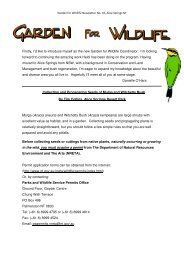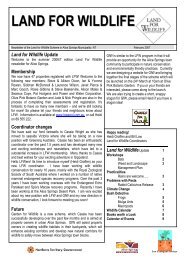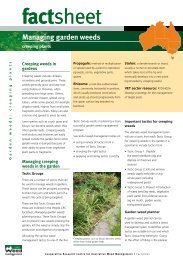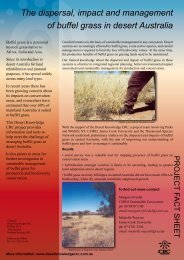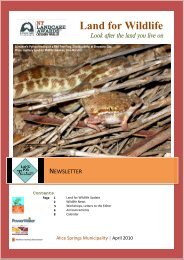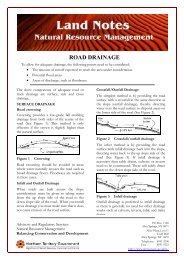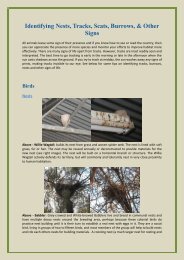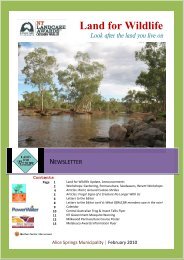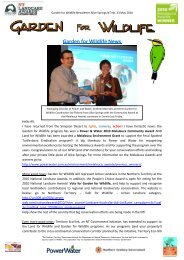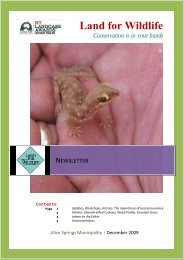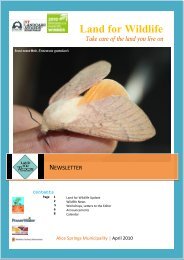GfW Jun 2010 - The Bowerbird Mystery (PDF 2 MB) - Land for Wildlife
GfW Jun 2010 - The Bowerbird Mystery (PDF 2 MB) - Land for Wildlife
GfW Jun 2010 - The Bowerbird Mystery (PDF 2 MB) - Land for Wildlife
Create successful ePaper yourself
Turn your PDF publications into a flip-book with our unique Google optimized e-Paper software.
For more in<strong>for</strong>mation on soil conservation see our website:<br />
http://www.lowecol.com.au/lfw/gfwmeminfo.htm. You will find ‘<strong>Land</strong> Notes’ on topics such as<br />
Understanding Water Movement, Road Drainage, Whoaboy Construction, Rehabilitating Degraded<br />
Sites, Gully Rehabilitation, Building Tracks & Roads to Minimise Erosion. Erosion is not a common<br />
problem on urban blocks, however if anyone is interested in having Col Stanton come to have a look<br />
at any problems you think you may have on your property, contact him on colin.stanton@nt.gov.au<br />
or 8951 9208. <strong>The</strong> consultation is free and well worth it. Col visited the block I live on and I now<br />
know where to put my whoaboys, and how to minimise problems in the future from water<br />
movement down the slope.<br />
3<br />
Things we learned in the workshop:<br />
<br />
<br />
<br />
<br />
<br />
Soil erosion is a natural process as water moves along natural drainage channels or as wind<br />
shifts sand dunes, however with human interference erosion is accelerated and the<br />
landscape cannot cope with the change in water flow. Some of the results of accelerated<br />
erosion are demonstrated in the pictures below.<br />
Let water flow where it wants to naturally flow historically. By altering flow direction<br />
problems will arise and greater ef<strong>for</strong>ts will be required to prevent erosion.<br />
Build roads and tracks along the contour of a slope. If tracks are built straight up the slope<br />
(the steepest, but most direct route) water will be funnelled down the tracks, washing soil<br />
away and creating a gully<br />
Do not rehabilitate gullies by simply throwing logs or debris into them. It may create larger<br />
and deeper gullies. Geo-textile fabric should be laid down first to help marry the infill to the<br />
gully.<br />
If you notice new gullies, rills, sheet erosion, tunnel erosion or wind erosion look upslope <strong>for</strong><br />
causes or changes. <strong>The</strong> problem is always upslope from the gully head. Pictured below Col<br />
points out a gully <strong>for</strong>ming caused by a mound of dirt piled<br />
upslope changing and intensifying the flow of water. <strong>The</strong><br />
gully head can be repaired, but will only <strong>for</strong>m again if the<br />
cause of the problem is not dealt with first. Once the cause<br />
of the problem is fixed, the gully will fix itself. Pictured left<br />
are exposed Hakea tree roots caused by the gully as soil<br />
washes away. In many cases this can result in the tree falling<br />
down or dying from lack of water.<br />
Right: A gully head worms its way through<br />
the soil. <strong>The</strong> cause is an unnatural change in<br />
water flow upslope. This site has severe<br />
erosion problems. <strong>The</strong> photos below<br />
demonstrate minor, easily repairable gullies.<br />
“<strong>The</strong> Northern Territory Government through the Department of Natural Resources, Environment, the Arts and Sport is pleased to<br />
sponsor <strong>Land</strong> <strong>for</strong> <strong>Wildlife</strong>. This publication may not represent the views of the Northern Territory Government”



